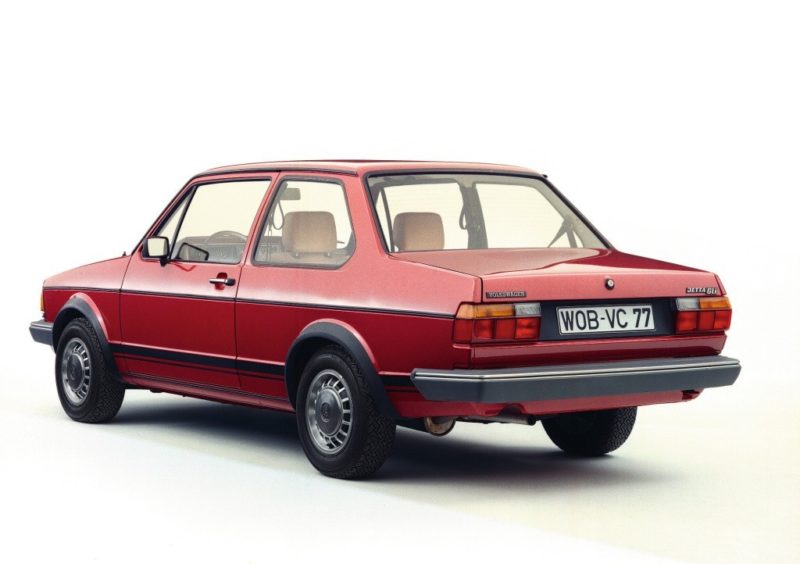In 1979 Volkswagen presented the Jetta at the IAA in Frankfurt. It was the result of the assignment Italdesign received from VW to design a classically designed model. The Jetta was supposed to come in between the Golf and the Passat. Giorgetto Giugiaro's pen strokes resulted in a successful car. He shared a lot with his smaller brother, but got a face of his own. The VW Jetta became especially popular in America.
The reason for Volkswagen to build the Jetta was decided in America. There was still a good market for classically designed cars there in the second half of the XNUMXs. The Golf was successful there as Rabbit, and Volkswagen saw potential in the development of a variant with a classic trunk based on VW's success number. It is therefore not surprising that Giugiaro designed a car that resembled the Golf in many ways. This was not only the case in appearance. The technicians also took over the Golf's chassis. And that meant triangles and McPherson struts at the front and the connecting shaft at the rear. The VW Jetta also got a rear stabilizer bar because of the heavier rear.
Wide range of engines
The VW Jetta, which was available with two and four doors, also had many similarities with the Golf in terms of powertrains. During the construction period of the first generation of the Jetta, Volkswagen offered the model with various petrol engines. They had a capacity of 1,1 liters (50 DIN-PK) to 1,8 liters with (112 DIN-PK). The diesels had displacements of 1,6 liters 40 kW (54 DIN-HP) and 51 kW (70 hp). The latter variant was a Turbo diesel and was available for model year 83. The non-blown self-igniter entered the Jetta program in the late 1980s. The 1.5 diesel was never available in the Jetta.
Carburation and injection
The gasoline engines had downstream carburettors. The exception was the powerful 1.6 and 1.8 engines, known from the Golf GTI, with 81 kW (110 DIN-PK) and 82 kW / 112 DIN PK), respectively. Both engines had the mechanical injection system BOSCH K-Jetronic) on board and were standard coupled to a five-speed (4 gears plus overdrive).
Various engines, various transmissions
The Turbodiesels also received a 4 + E standard. It was available as an option on models with the 1.5 (JB, 70 DIN-PK), the 1.6 (FG, 85 DIN-PK) and the 1.6 diesel, which strengthened the range from model year '81. The 1.1 Formel E had a 3 + E gearbox. The 1.3 had the four-speed gearbox. The buyer could not order an alternative transmission for the two smallest engine variants of the VW Jetta. The mentioned 1.5 and 1.6 variants were also available with a 3-speed automatic transmission.
GLI: the top version
The Jetta was available in various versions, which in turn could often be ordered in combination with one or more engine variants. The options were market dependent. The highlight in the series was the GLI. In the VW Jetta, that was actually the GTI variant, which could safely be called a desirable sports sedan. Until model year 1983, it received the 1.6 engine with 110 HP. After this, just like the Golf GTI, Volkswagen fitted the 1.8 variant with 112 HP. A few features. For example, the GLI got a lowered sports suspension, a front stabilizer, a thicker rear stabilizer, ventilated front discs, widened sheet metal and a four-spoke leather sports steering wheel.
Experience curve and equipment makes Jetta mature
Volkswagen actually made every Jetta a bit more luxurious than the comparable Golf versions from those years. In addition, the clock shop (at least until 1981) deviated from the Golf instruments. The front was characterized by rectangular headlamps with integrated direction indicators. And of course, the Jetta had the classic trunk, which offered a luggage space of 630 liters. The light units on the stern also had their own look. In addition, the VW Jetta was the first Volkswagen to be equipped with rust preservation in the cavities before assembly. In addition, he took advantage of the improved sheet steel that Volkswagen used for its products in the late XNUMXs.
Nearly 600.000 times Type 16
The VW Jetta was not only a Golf with butt for Volkswagen, it was also a car with which VW went higher. In this way he also made the distinction with the extremely popular Golf. It was a beautifully designed and mature model in the Volkswagen range. He fitted well in the then range. In addition, the VW Jetta became popular in the United States. Volkswagen hit the mark with the Jetta, which is the best-selling European car (all generations) in the United States to date. The first generation of the Jetta -Typ 16- was built almost 1979 times from August 1984 to the beginning of 600.000.



We have had two different models / types. Wonderful cars very spacious. Mark…. with 1800cc automatic transmission, I took down the starter motor several times, each time for free. The starter motor did not turn around, not to be found, especially when it was hot a big problem. Even placed a relay in between as an auxiliary relay, that didn't help either. Very annoying if you have just refueled and you are in the Czech Republic.
For years, the KS-50-YT had a lot of fun and holiday rides